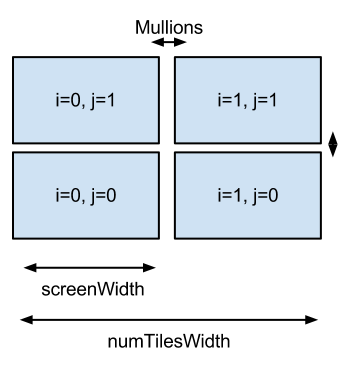-
Notifications
You must be signed in to change notification settings - Fork 10
Creating A Configuration File
Suppose you have a distributed display such as that pictured above. It has 4 screens, each connected to a different computer. Each screen has a resolution of 400X400 pixels. Furthermore, here we assume that the bezels of the screens are non-existent, so we say the mullions are 0 pixels. If you want to do bezel compensation, you can put positive pixel offsets here. The computers hostnames are all localhost here, because we want to run this test on our computer. You would replace these with proper hostnames in a distributed environment. 1 is the bottom left, 2 the bottom right, 3 top left, 4 top right. You also intend to have a master process running on a local screen, on host localhost.
- numTilesWidth = 2, numTilesHeight = 2
- screenWidth = 400, screenHeight = 400
- mullionWidth = 0, mullionHeight = 0
The configuration file would look like this for the display above:
<configuration>
<dimensions numTilesWidth="2" numTilesHeight="2" screenWidth="400" screenHeight="400" mullionWidth="0" mullionHeight="0" debug="0"/>
<head host="localhost" port="9002" display=":0" rank="0">
<screen width="400" height="400"/>
</head>
<process host="localhost" display=":0" rank="1">
<screen x="0" y="0" i="0" j="0"/>
</process>
<process host="localhost" display=":0" rank="2">
<screen x="0" y="0" i="0" j="1"/>
</process>
<process host="localhost" display=":0" rank="3">
<screen x="0" y="0" i="1" j="0"/>
</process>
<process host="localhost" display=":0" rank="4">
<screen x="0" y="0" i="1" j="1"/>
</process>
</configuration>The configuration file has a element for each display. In the case that there might be a computer driving two monitors, you might have two elements for that process, and one of the elements would have x and y offsets.
